The Classic San Francisco Cocktail: A Sophisticated Sloe Gin Martini Twist
Experience the allure of the San Francisco Cocktail, a delightful twist on the classic martini that’s both smooth and elegantly sweet. This low ABV concoction, featuring the unique richness of sloe gin, the complexity of vermouth, and a subtle hint of bitters, offers a refined drinking experience. Perfect for those who appreciate a cocktail with depth, character, and a fascinating origin story.
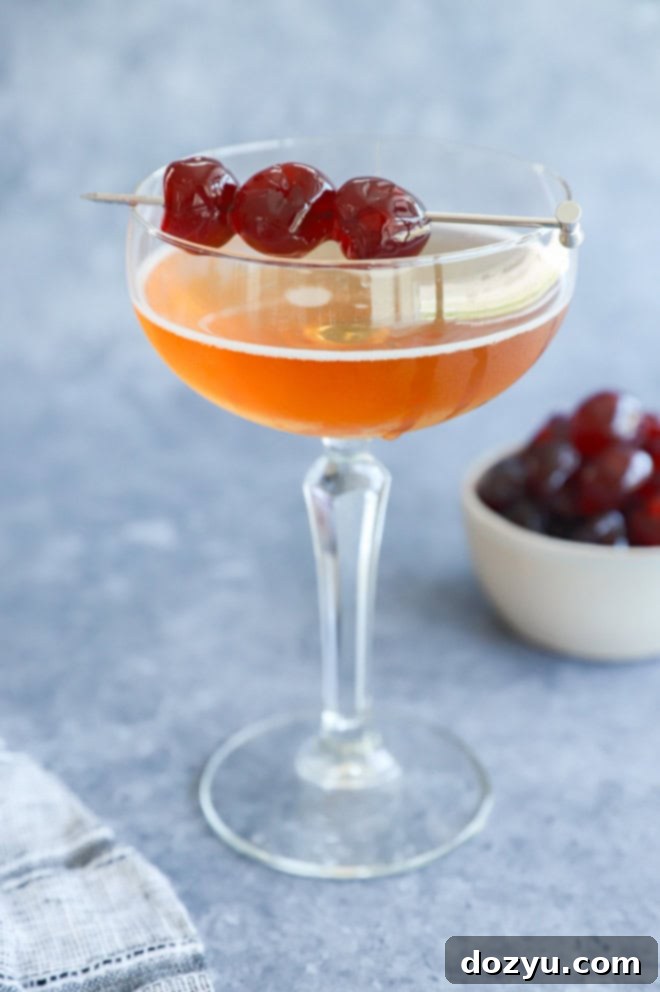
Table of Contents
Toggle
About the Classic San Francisco Cocktail
If your palate gravitates towards the crisp elegance of a gin martini but occasionally yearns for something subtly sweeter and more nuanced, the San Francisco Cocktail is your next essential libation. This hidden gem has quietly captivated cocktail enthusiasts for decades, offering a refreshing departure from its drier counterparts. It’s a testament to timeless mixology, merging classic techniques with a distinct, approachable flavor profile.
What makes this cocktail truly special is its unique balance. It boasts a fascinating interplay of fruity and dry notes, underpinned by an herbaceous complexity. Unlike many traditional martinis, it carries a gentle sweetness that rounds out its edges, making it incredibly smooth and eminently drinkable. Each sip reveals layers of flavor, from the rich plum notes of sloe gin to the botanical nuances of vermouth, all harmonized by a dash of bitters. It’s an all-around fantastic choice for anyone who loves gin and appreciates a well-crafted, sophisticated drink.
Surprisingly, this “San Francisco” cocktail first graced the pages of a British cocktail book, adding a whimsical twist to its narrative. Born across the pond, it nonetheless embodies a certain West Coast sophistication – smooth, vibrant, and effortlessly chic. To us, it represents a beautiful blend of old-school charm and modern-day appeal, perfectly aligned with the renewed interest in classic cocktails gracing today’s best bars. While it might not be as ubiquitous as some of its contemporaries, the San Francisco Cocktail certainly deserves a prominent place in your home bar repertoire.
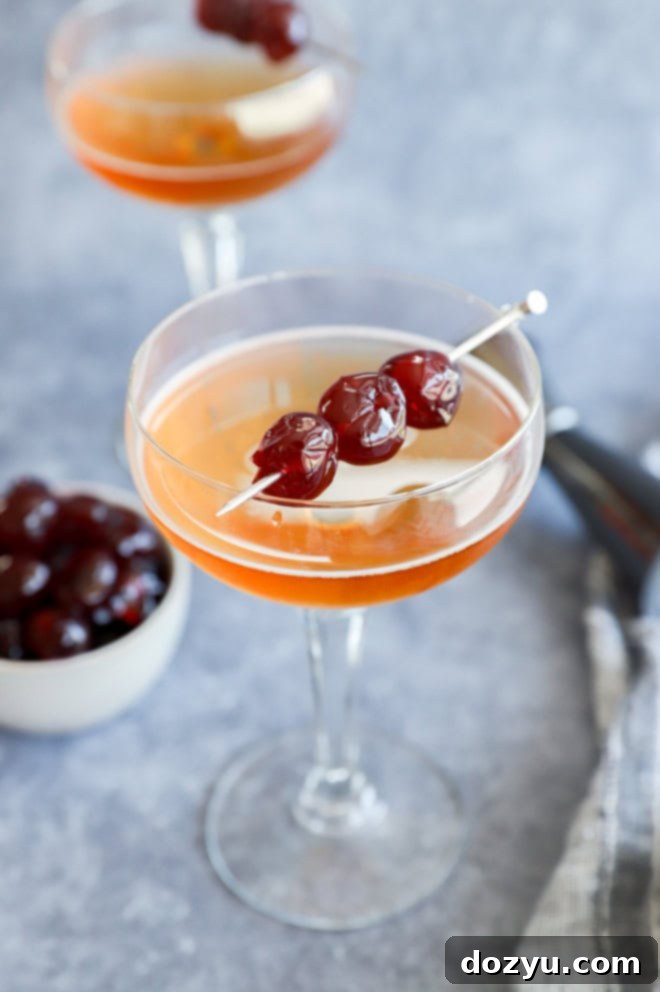
Essential Ingredients and Equipment
Creating an exceptional San Francisco Cocktail starts with understanding its core components. Each ingredient plays a vital role in building the drink’s signature flavor profile. Additionally, having the right bar tools makes all the difference in achieving a perfectly mixed, elegantly presented cocktail.
Key Ingredients
- Sloe Gin: This is the star of the show. Unlike traditional gin, sloe gin is a liqueur made by infusing gin with sloe berries (a small, tart plum-like fruit) and sugar. This process gives it a distinctive sweet, fruity, and slightly almond-like flavor. Its rich ruby hue also contributes to the cocktail’s visual appeal. For the best results, opt for quality brands like Hayman’s Sloe Gin or Sipsmith Sloe Gin, known for their balanced sweetness and authentic sloe berry character. While you could substitute with regular gin, you would lose the defining sweet and fruity essence of this particular San Francisco cocktail.
- Vermouth (Dry & Sweet): The San Francisco Cocktail cleverly utilizes both dry (or French) and sweet (or Italian) vermouths. Dry vermouth, typically pale and less sweet, brings herbaceous, floral, and sometimes bitter notes, contributing to the drink’s dryness and complexity. Sweet vermouth, often red and richer, adds depth, sweetness, and notes of caramel, spice, and dark fruit. The combination of both creates a beautifully layered flavor that provides an aromatic foundation for the sloe gin. Always ensure your vermouth is fresh, as it can oxidize and spoil quickly once opened. Store it in the refrigerator after opening to extend its shelf life.
- Bitters (Angostura & Orange): Bitters are the secret weapon of any good cocktail, adding aromatic complexity and tying flavors together. This recipe calls for a blend of Angostura bitters and orange bitters. Angostura offers warm, spicy notes of clove, cinnamon, and gentian, while orange bitters provide bright, citrusy aromatics. This combination enhances the fruitiness of the sloe gin and the botanicals of the vermouth, adding subtle layers of flavor that elevate the drink from good to extraordinary. Don’t be afraid to experiment with other bitters, as discussed later, to fine-tune the flavor to your preference.
- Brandied Cherries: The perfect garnish for this elegant drink. Brandied cherries, soaked in brandy and often spiced, offer a luxurious sweetness and a beautiful visual pop. They are a significant upgrade from ordinary maraschino cherries, adding another layer of sophisticated flavor that complements the cocktail’s profile.
Must-Have Equipment
You don’t need a professional bar setup to make this cocktail; just a few essential tools will do the trick:
- Cocktail Shaker: Essential for thoroughly mixing and chilling the ingredients. A good shaker ensures all components are well integrated and perfectly cold.
- Jigger: For precise measurement of your spirits and vermouth. Accuracy is key in cocktail making to maintain the perfect balance of flavors.
- Cocktail Strainer: To separate the chilled liquid from the ice, ensuring a smooth, undiluted drink.
- Coupe or Martini Glasses: While any elegant cocktail glass will work, coupe glasses are traditionally used for this type of drink, offering a sophisticated presentation. Martini glasses are also an excellent choice. Remember to chill your chosen glass beforehand for the best experience!
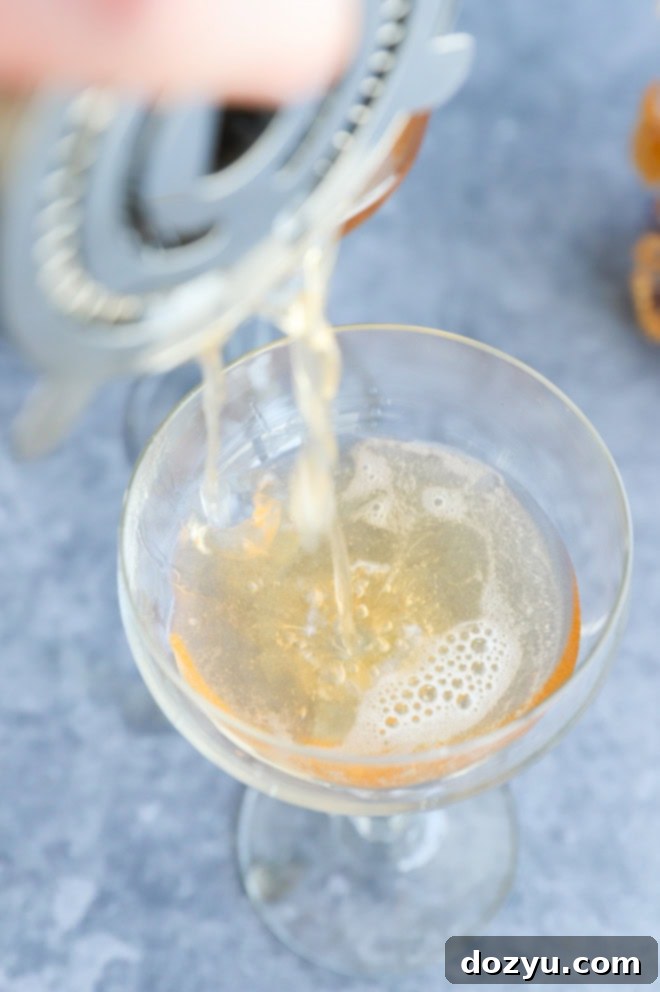
Crafting Your San Francisco Cocktail: Step-by-Step
Making this sophisticated cocktail is straightforward, but a few key steps will ensure a perfect result every time. Follow these instructions for a perfectly balanced and chilled San Francisco Cocktail:
Prepare and Shake
- Chill Your Glass: The first and most crucial step for any spirit-forward cocktail is to chill your serving glass. Place your coupe or martini glass in the refrigerator or freezer for at least 5-10 minutes before you begin mixing. A cold glass helps maintain the drink’s temperature, preventing rapid dilution and ensuring a crisp, refreshing sip from start to finish. Avoid using ice directly in the serving glass, as this will water down your carefully crafted drink.
- Measure Ingredients: Using your jigger, precisely measure out the sloe gin, dry vermouth, sweet vermouth, Angostura bitters, and orange bitters. Accuracy in measurement is paramount for achieving the ideal flavor balance.
- Combine and Shake: Fill your cocktail shaker two-thirds full with fresh, quality ice cubes. Add all the measured liquid ingredients to the shaker. Secure the lid tightly and shake vigorously for about 15-20 seconds. You want to hear the ice clinking loudly against the shaker walls. This rapid shaking not only chills the cocktail thoroughly but also properly mixes and slightly aerates the ingredients, contributing to its smooth texture. You’ll know it’s sufficiently chilled when the outside of the shaker becomes frosted.
Strain and Serve
- Strain into Chilled Glass: Remove your chilled glass from the freezer or fridge. Using a cocktail strainer (such as a Hawthorne or Julep strainer), strain the contents of the shaker directly into your prepared glass. Ensure no ice chips or fragments fall into the drink, as this will lead to unwanted dilution.
- Garnish and Enjoy: The final touch is the garnish. Carefully place one or two brandied cherries into the cocktail. Their rich color and sweet-tart flavor beautifully complement the drink. Serve immediately and savor the elegant, complex flavors of your homemade San Francisco Cocktail.
Tips for a Flawless San Francisco Cocktail
Achieving cocktail perfection often comes down to small details. Here are some pro tips to ensure your San Francisco Cocktail is nothing short of excellent:
- Prioritize High-Quality Ingredients: In spirit-forward cocktails like this one, the quality of each component shines through. Invest in good sloe gin, reputable dry and sweet vermouths, and fresh bitters. High-quality ingredients lead to a smoother, more refined flavor profile that truly elevates the drink. Think of it as cooking; the better your produce, the better your meal.
- Check Your Vermouth’s Freshness: This is a frequently overlooked but critical point! Vermouth, being a fortified wine, has a shorter shelf life than hard spirits once opened. Exposure to air can quickly degrade its delicate flavors, turning it flat or even sour. It’s generally recommended to consume an opened bottle of vermouth within three months, storing it tightly sealed in the refrigerator. If your vermouth has been sitting on the shelf for longer, it’s best to replace it. A spoiled vermouth can ruin an otherwise perfect cocktail.
- Master the Chill: We mentioned chilling the glass, but also ensure your ice is fresh and solid. Watery ice will dilute your drink too quickly during shaking. The goal is maximum chill with minimal dilution.
- Experiment with Bitters: While Angostura and orange bitters are classic for a reason, don’t hesitate to explore. As detailed in a later section, different bitters can dramatically alter the drink’s nuance, offering a personalized touch.
- Consider Your Garnish: Brandied cherries are ideal, but if unavailable, a twist of orange peel can add a beautiful aromatic dimension without adding sweetness. The oils from the orange zest will complement the gin and bitters.
- Shake, Don’t Stir (for this cocktail): Although martinis are often stirred, this cocktail benefits from shaking due to the sloe gin and vermouths. Shaking helps to integrate the flavors more thoroughly and achieve a slightly lighter texture than stirring would.
More tasty gin cocktails to sip on: Gin Sling | Blackberry Gin Fizz | Strawberry Gin Smash | Watermelon Gin Cocktail | Irish Coffee
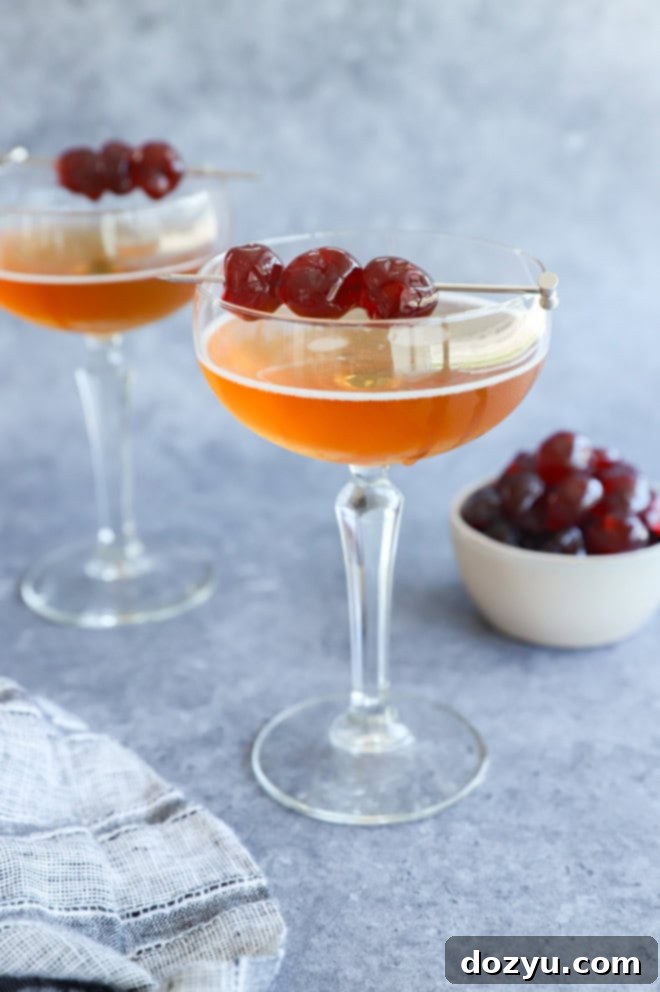
Are There Two San Francisco Cocktails?
Indeed, there’s a fascinating duality to the “San Francisco Cocktail” name! While this article celebrates the classic, sophisticated sloe gin-based martini variation, there is a completely different drink that also bears the same name, particularly popular in some modern interpretations and often found in more casual, fruit-forward bar settings.
The second, modern San Francisco Cocktail is a vibrant, often tropical, concoction. It typically features vodka as its base, combined with banana liqueur, grenadine, and a medley of tropical fruit juices, such as orange or pineapple. The flavor profile is a world apart: intensely sweet, fruity, and designed to evoke a sunny, vacation-like vibe. It’s a fun, approachable drink for those who prefer bolder, sweeter flavors.
The distinction between these two drinks couldn’t be starker. One is an elegant, balanced, spirit-forward cocktail with historical roots, offering subtle sweetness and complex herbal notes. The other is a playful, dessert-like drink bursting with tropical sweetness. While both have their charm, for connoisseurs of classic mixology and those who appreciate depth over overt sweetness, our sloe gin-based San Francisco Cocktail is undoubtedly the preferred choice, offering a unique and memorable experience that stands the test of time.
The Surprising Origin of This Cocktail
The story of the San Francisco Cocktail is as intriguing as its flavor. Despite its evocative name, this particular martini variation did not originate in the golden city by the bay. Its true birthplace is actually quite unexpected: the United Kingdom. This elegant drink first appeared in the esteemed Cafe Royal Cocktail Book, published by the UK Bartenders Guild in 1937.
The Cafe Royal Cocktail Book was a seminal collection, meticulously documenting a plethora of cocktail recipes that were popular throughout the 1920s and 1930s. Many of these recipes, once known only to a select few, have since become foundational standards in the world of mixology – think of iconic drinks like the Margarita or the Bloody Mary, whose early iterations or influences can often be traced back to such historical compilations. The book served as a vital repository, preserving the creativity and craftsmanship of an era that truly laid the groundwork for modern cocktail culture.
It’s an amusing twist of fate that a drink named after a quintessentially American city found its initial fame across the Atlantic. However, one could argue that the smooth, sophisticated, and slightly mysterious flavor of this cocktail perfectly captures the spirit of San Francisco itself—a city renowned for its elegance, innovation, and vibrant cultural tapestry. Regardless of its geographical origin, the San Francisco Cocktail, with its unique blend of sloe gin, vermouth, and bitters, has certainly earned its place in the pantheon of classic drinks, proving that a great cocktail can transcend borders and capture the imagination, no matter its namesake.
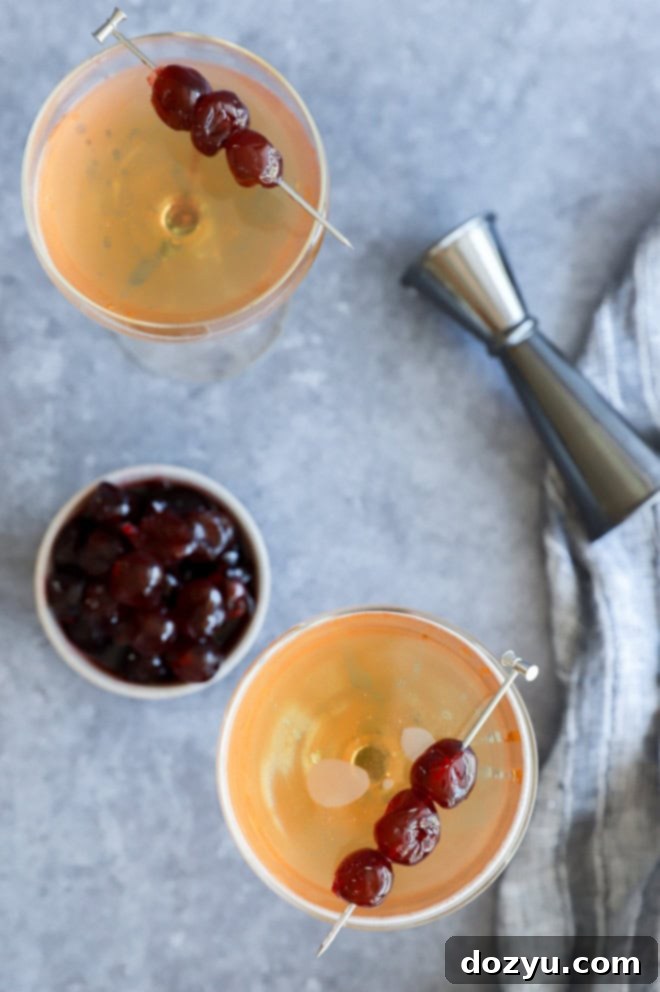
Can I Customize the Bitters?
Absolutely! One of the most enjoyable aspects of crafting cocktails at home is the freedom to experiment, and the bitters in a San Francisco Cocktail offer a fantastic canvas for customization. While the classic combination of Angostura and orange bitters provides a wonderfully balanced foundation, swapping or adding different bitters can introduce exciting new dimensions to your drink, allowing you to tailor it perfectly to your taste.
Bitters are highly concentrated alcoholic infusions made with botanicals, herbs, roots, and fruits, and just a dash can profoundly impact a cocktail’s aromatic profile. If you’re looking to enhance the fruity elements, consider using smoked orange bitters for a deeper, more complex citrus note, or even cherry bitters to complement the sloe gin’s plum-like sweetness and the brandied cherry garnish. These variations can bridge the flavor gap and create a more cohesive taste experience.
For those daring to explore further, the world of bitters is vast. You could try chocolate bitters for a subtle, rich undertone that surprisingly pairs well with berry notes, or even more exotic options like alpino bitters for an herbaceous, slightly alpine forest character. If you have any favorite bitters on hand, don’t hesitate to try them in small increments. Start with one dash, taste, and adjust. This iterative process allows you to discover unique combinations and truly make the San Francisco Cocktail your own signature drink. Experimentation is key to unlocking new flavor experiences!
Sloe Gin vs. Traditional Gin: What’s the Difference?
Understanding the distinction between sloe gin and traditional gin is crucial for appreciating the unique character of the San Francisco Cocktail. While both share the “gin” name, they are fundamentally different spirits, serving distinct roles in mixology.
- Traditional Gin: At its core, traditional gin is a distilled spirit predominantly flavored with juniper berries. By law in most regions, juniper must be the most prominent botanical. Beyond juniper, distillers use a diverse range of botanicals—such as coriander seed, angelica root, citrus peels, and various spices—to create unique flavor profiles. The process involves distilling a neutral spirit with these botanicals, resulting in a clear, dry, and often highly aromatic spirit. Its flavor is typically herbaceous, piney, and sometimes citrusy, with a crisp, clean finish. Traditional gin is the base for classic cocktails like the Gin & Tonic, Negroni, and, of course, the classic Gin Martini.
- Sloe Gin: Sloe gin, on the other hand, is not a distilled gin in the same sense. It’s actually a liqueur made by infusing gin with sloe berries and sugar. Sloe berries are small, dark, tart fruits from the blackthorn tree, similar to a plum. They are typically steeped in gin (often for several months) along with sugar, allowing the flavors and vibrant ruby color of the berries to infuse into the spirit. The result is a much sweeter, fruitier, and typically lower-ABV spirit than traditional gin. Its flavor is reminiscent of plums, almonds, and red berries, with a pleasant sweetness that cuts through the gin’s botanical notes. This infusion process makes sloe gin a liqueur rather than a true gin, often enjoyed as a digestif or as a key ingredient in sweeter cocktails like the San Francisco Cocktail, where its fruity sweetness is essential.
In essence, traditional gin is a botanical spirit with a dry profile, while sloe gin is a berry-infused, sweetened liqueur. For the San Francisco Cocktail, the specific sweet and fruity notes of sloe gin are integral to its identity, though you can certainly experiment with traditional gin for a much drier, more classic martini-like experience, albeit one that deviates significantly from the original recipe’s intended flavor.
Need some inspiration for your next gathering? Check out my easy appetizer recipes page!
What to Serve with a San Francisco Cocktail
The San Francisco Cocktail, with its sophisticated balance of sweet, dry, and herbaceous notes, is remarkably versatile when it comes to food pairings. Its low ABV and complex flavor make it an excellent choice for various occasions, from pre-dinner aperitifs to a refined accompaniment for a main course.
- As an Aperitif: This cocktail shines brightest as an aperitif, designed to stimulate the appetite before a meal. Its nuanced profile pairs beautifully with classic pre-dinner bites. Think savory and briny options like a medley of cured olives, a selection of fine cheeses (especially goat cheese, aged cheddar, or a creamy brie), and other pickled delights like cornichons or marinated artichoke hearts. These flavors enhance the cocktail’s botanicals and cut through its sweetness, preparing the palate for the meal to come. Consider serving it alongside a well-curated charcuterie board for an elegant start to any gathering.
- With Hearty Main Courses: Surprisingly, this martini variation also holds its own against more substantial dishes, particularly those featuring rich meats. Its herbaceous and slightly fruity character can complement the savory depth of steak. Fire up the grill for a perfectly seared grilled NY strip steak, where the cocktail’s subtle sweetness can balance the meat’s char and richness. It also pairs wonderfully with the smoky, spiced flavors of easy steak fajita foil packets, adding a refreshing counterpoint to the vibrant Mexican-inspired spices.
- Dessert Pairings: For those with a sweeter tooth, consider serving it alongside lighter fruit-based desserts, or even a dark chocolate mousse, where the cocktail’s fruity notes can mingle beautifully with cocoa.
Ultimately, the San Francisco Cocktail’s versatility allows it to adapt to your menu, making it a reliable and delightful choice for almost any culinary occasion.
More Easy and Classic Cocktails to Make
If you’ve enjoyed the classic elegance of the San Francisco Cocktail, you’re likely to appreciate these other easy-to-make classic and modern classic cocktails:
- A Patron margarita is the epitome of fresh and vibrant, relying solely on fresh citrus juice to let the premium Patron tequila truly shine.
- This bitter and beautifully balanced aperol negroni serves as a fantastic signature drink, perfect for impressing guests at your next cocktail party.
- For a zesty kick, a chili salty dog offers a spicy twist on the traditional recipe, enhancing its juicy and flavorful profile.
- Indulge in a rich bourbon manhattan cocktail, a superb variation that substitutes bourbon for the traditional rye whiskey, offering a smoother, sweeter experience.
- Discover the paper plane cocktail, a modern classic known for its unique and intriguing flavor profile that you’re sure to fall in love with.

Finally, if you make this San Francisco cocktail recipe, please be sure to give this recipe a star rating on the recipe card and/or leave a comment! I love to hear when you all make recipes, and I do take the time to respond to every single comment.
Feel free to drop questions below too, if you have them!
Oh, and be sure to tag me on Instagram, Facebook, or Pinterest if you make the recipe! I love being able to see these recipes come to life in your homes – it’s my favorite thing to look through those photos. It really means the world to me!
Want to know when I come out with a new recipe or the latest news? Sign up for my newsletter!

San Francisco Cocktail Recipe Card
5 minutes
5 minutes
1
cocktail
prevent your screen from going dark
Equipment
-
Double Jigger
-
cocktail shaker
-
OXO Steel Cocktail Strainer
Ingredients
- 1 oz sloe gin
- 3/4 dry vermouth
- 1 oz sweet vermouth
- 1 dash Angostura bitters or aromatic bitters
- 1 dash orange bitters
- Brandied cherries for garnish
Instructions
-
Add sloe gin, both vermouths, and both bitters to a cocktail shaker filled with ice. Shake well until thoroughly chilled, about 15-20 seconds.
-
Strain into a pre-chilled martini or coupe glass.
-
Garnish with one or two brandied cherries. Serve immediately and enjoy.
Video
Nutrition
94
kcal
English
Booze
